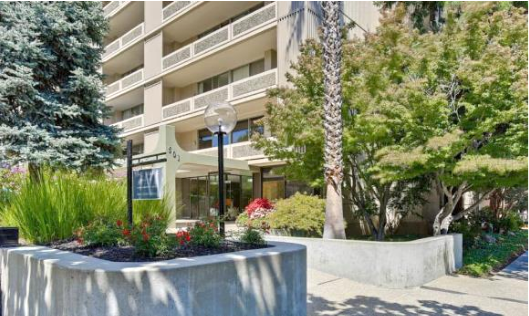
This story was originally published Nov. 19 in the print edition of the Daily Post.
BY ELAINE GOODMAN
Daily Post Correspondent
Palo Alto is looking at reducing parking requirements for new multifamily housing projects in the city — including affordable and market-rate projects — as a way to encourage development of more housing.
The proposal is contained in an ordinance that City Council is scheduled to vote on Monday, Nov. 26.
Other ideas in the ordinance include relaxing requirements for ground-level retail in affordable housing projects and streamlining the review process for multifamily housing proposals.
Open-space requirements for new housing are also covered in the ordinance, including standards that would be applied when rooftops are used as open space.
“The value of the proposed ordinance is that it streamlines project review, increases unit density, adjusts parking requirements to be more aligned with industry standards and modifies other development regulations that constrain housing development,” City Manager Jim Keene said in a report to the council.
The ordinance is a product of the city’s housing work plan that the council approved in February. The proposals were reviewed by the Planning and Transportation Commission during a series of meetings this year. The city also hosted 16 meetings with architects and developers to discuss the proposed changes.
In addition, a community meeting was held in June, where a range of perspectives were expressed on the city’s housing crisis and potential solutions — particularly parking.
Consultant’s view of parking demand
The proposed reduction in parking requirements for multifamily housing is based partly on a consultant’s study that reached what may be a surprising conclusion: Parking supply is greater than demand for market-rate as well as affordable housing in Palo Alto.
Consultant Fehr & Peers looked at parking demand at nine multifamily housing projects in the city. Parking demand was highest at market-rate projects and lower at affordable or senior housing projects, the study found.
One of the sites studied was The Marc, an apartment complex that is 0.7 miles from the downtown Caltrain station. The project provides 0.92 parking spaces per bedroom, but peak demand is only 0.58 spaces per bedroom, according to the consultant’s report.
“This suggests that there are opportunities to reduce parking requirements without creating spillover impacts or an undersupply of available parking,” Keene said in his report to the council.
Some residents who attended the community meeting in June were skeptical about the study.
“The study seems deeply flawed and counterintuitive to neighborhood experience,” one person said in written comments. “Seriously, in five years, the entire city will need RPP (residential parking permits).”
New parking requirements
New housing projects are now required to supply 1.25 or 1.5 parking space for each studio or one-bed-room apartment, respectively.
The proposed ordinance would reduce that to one parking space per unit for either unit type — and to 0.8 parking space per unit if the housing is within a half mile of a train station. Those projects would be required to provide annual transit passes to residents.
Two parking spaces would be required for each housing unit with two or more bedrooms — the same as the current requirement. That would be reduced to 1.6 parking spaces per unit for projects close to the train station. Additional parking for guests would not be required.
For affordable housing projects, developers now may ask for a parking reduction from the city, which reviews the request and then approves or denies it.
The proposed ordinance would give affordable housing a parking reduction “by right,” meaning without a review process. The reduction is 20% for low-income housing, 30% for very low and 40% for extremely low-income housing.
What about retail?
Another issue addressed in the proposed ordinance is the impact of ground-level retail requirements on housing development.
While preserving ground-level retail has been a goal in some parts of town, some have said that objective is at odds with affordable-housing development.
A representative of the nonprofit Palo Alto Housing told the council in February that his organization was looking outside Palo Alto to build low-income homes because it wasn’t able to get grants and tax-exempt bonds that require developments to be 100% affordable housing.
“Mixed use is great, but it can’t get in the way of getting housing units built,” commented one person who attended the city’s community meeting in June.
Others were more supportive of retail.
“If trade-off is necessary, (I’m) OK with prioritizing housing over retail,” a resident said in a written comment. “But (I) would prefer mixed use, and support increasing height limits to accomplish this.”
The proposed ordinance would exempt 100% affordable housing projects from the retail preservation requirement, except along El Camino Real, and in the city’s ground floor and retail combining districts downtown and in the California Avenue District.
Open space
Regarding open space, the ordinance would allow rooftops to qualify for up to 75% of the open space requirement for multifamily projects downtown; or 60% of the open space requirement in the California Avenue district or along El Camino Real.
The city zoning code requires open space for residential uses in commercial districts. Standards would apply to the rooftop open space to address privacy, noise, visibility, odors, and safety, the city said.




Palo Alto residents would want to look at what neighboring Los Altos approved as ordinances recently. Salient features:
1) Los Altos only requires covered parking for 1 car in residential lots. That requirement remains in place. No matter how big a lot or house the Code only requires 1 car per lot.
2) Accessory structures now permitted on any lot with no side setback required.
3) The old Code required 15000 sq ft lot size for ADUs which were limited to 800 sq ft. That requirement was eliminated. Now ADUs of up to 1200 sq ft allowed on any lot.
4) The old Code required owner occupancy i.e., if a lot had an ADU the owner was required to live in either the main residence or ADU. The new Code eliminates that requirement.
5) The aforementioned accessory structures (even if on the side property line) can then be converted to ADUs.
6) NO parking required for ADUs.
What you have is a set up for developers to buy residential properties, erect accessory structures on side property lines, convert them to ADUs, rent out both the main residence and ADU. The Code requires only parking for 1 car…which leads to the reasonable and logical and likely conclusion the vehicles of the tenants (main residence and ADU) would be parked on the street.
All this was passed under the false pretext “The State Laws changed…our hands are tied…we have no option…”, echoed by the City staff, City Attorney, and Mayor working in concert.
From this article it appears contagion is working…with Palo Alto working hard to emulate Los Altos’ nefarious precedent. Wake up, Palo Alto!
I love this idea. I know the old timers and the NIMBYs will complain, but reducing parking requirements means a few more apartments can be added to each new building. Yes, these units will be expensive, but the people moving into them will vacate less expensive homes that will be available to people one rung down on the income ladder. The NIMBYs and “residentialists” are very selfish and couldn’t care less about the people who are struggling to pay the rent around here. If council approves this, they will deserve our applause.
>these units will be expensive, but the people moving into them will vacate
>less expensive homes that will be available to people one rung down on
>the income ladder
Chalk one more in the camp of “trickle down voodoo economics”. If you believe that I have a bridge to sell you. Real cheap!
Whether someone likes the idea or not is not the issue here.
What matters is the transparency and open governance expected of public servants who owe a duty of good faith and legal conduct of their responsibilities due the taxpayers of the city.
That was clearly lacking in Los Altos where residents were misled, misinformed, and lied to by City representatives (who, for all practical purposes, seem to have an agenda of their own that residents and taxpayers were not informed of).
Whether that contagion catches on in Palo Alto remains to be seen. My comment was to rouse up Palo Alto residents so they are aware of that possibility.
If Victor F. owned property, vs renting, odds are he would align with other “residentialists” and care about preserving the quality of life that brought him and others to the Bay Area. It must be easy to trash something when you don’t have any skin in the game and harder to look for the common and larger good that preserves what we have.
@wake up! is trying to use this issue in Palo Alto to grind his ax about Los Altos. Palo Alto can do so much more to encourage housing construction than it has, and this proposal looks like a good step forward.
[Comment deleted because of sockpuppeting.]